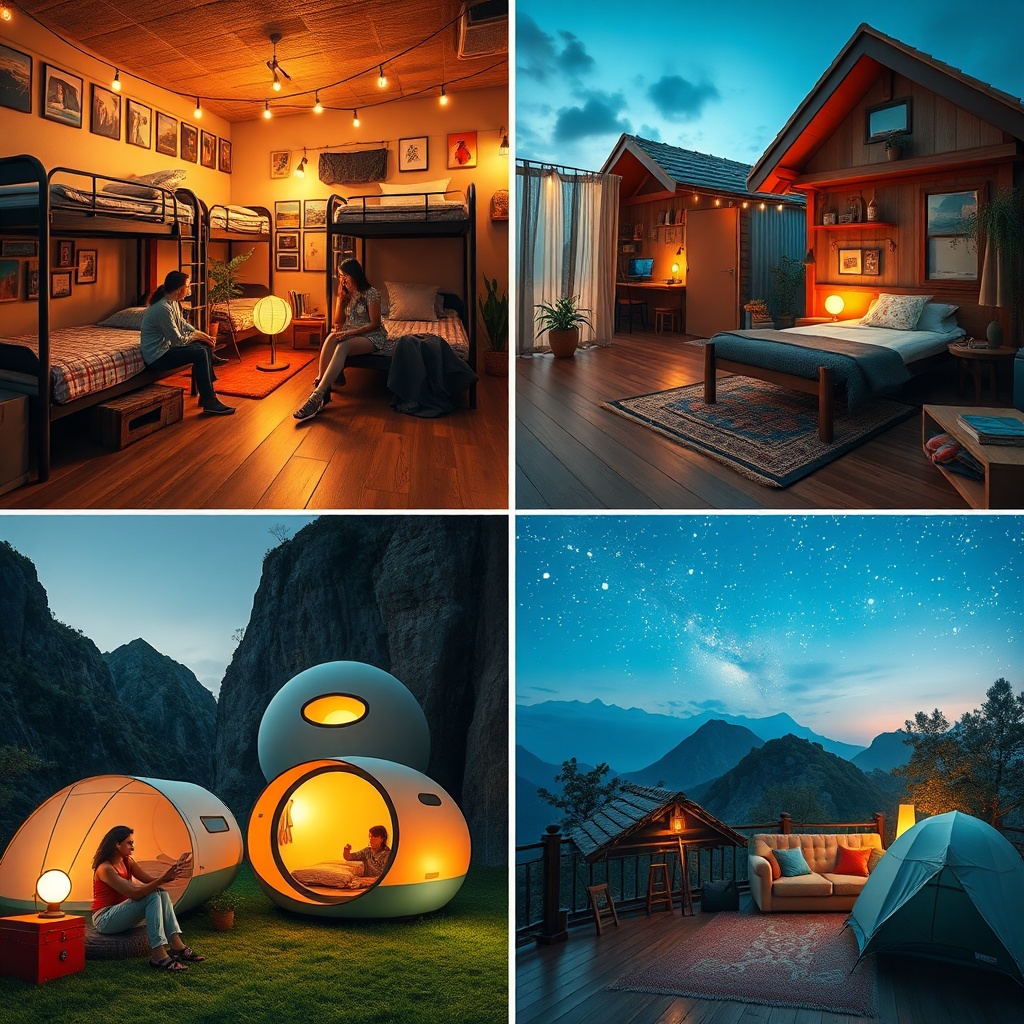Around the world budget table for realistic expenses (as of 2025)
Dreaming of circling the globe but think your wallet will never allow it? Picture yourself tasting street food in Bangkok, waking up in a hostel in Berlin, or snapping breathtaking photos on a sunny day in Lima—all without plunging into debt. The secret lies in knowing where your money goes and planning realistic, up-to-date budgets. Whether you’re a seasoned backpacker or a first-timer on a tight budget, our in-depth review of the latest (as of August 2025) travel expenses will help you understand how much you REALLY need to travel the world. Get the most recent, no-nonsense insights on accommodation, daily meals, transportation, and local experiences across popular continents. Let’s break down the numbers and demystify the myth that you have to be rich to see the world. Read on, and see if you’re ready to take the first real step on your own budget adventure—one that’s more possible than you think.

Traveling the world on a budget in 2025 is more accessible than ever, but one of the biggest decisions every traveler faces is: Where should you sleep? Choosing the right accommodation can dramatically impact both your expenses and your overall experience. Let’s explore realistic options, costs, and smart strategies for finding budget-friendly places to stay across the globe.
1. Hostels: The Classic Budget Choice
Hostels remain the go-to for budget travelers, especially in Europe, Southeast Asia, and South America.
In 2025, modern hostels offer more than just a bed in a dorm—they provide social spaces, coworking areas, and even free city tours.
Average price per night:
- Western Europe: $25–$40
- Southeast Asia: $7–$15
- South America: $10–$20
2. Guesthouses & Homestays: Local Living
Guesthouses and homestays offer a more authentic, local experience.
Prices vary by region, but they’re often cheaper than hotels and can include home-cooked meals or cultural activities.
Average price per night:
- India/Nepal: $8–$18
- Eastern Europe: $15–$30
- Latin America: $12–$25
3. Couchsurfing: Free & Social
Couchsurfing is ideal for adventurous travelers who want to connect with locals and save money.
While it’s free, always prioritize safety: read host reviews and communicate clearly before arrival.
Average price per night: Free (but consider bringing a small gift or helping with chores)
Tip: Couchsurfing is best for solo travelers or pairs, and works well in major cities worldwide.
4. Capsule Hotels: Urban Innovation
Originating in Japan, capsule hotels are now found in cities from Tokyo to Berlin.
They offer privacy, security, and comfort at a fraction of hotel prices.
Average price per night:
- Japan: $20–$40
- Europe: $25–$50
- Australia: $30–$60
5. Camping & Eco-Lodges: Nature on a Budget
If you love the outdoors, camping is a cost-effective and memorable way to sleep.
Many countries offer well-equipped campgrounds, and eco-lodges provide sustainable stays at reasonable prices.
Average price per night:
- Europe/USA (campgrounds): $10–$25
- Eco-lodges (worldwide): $15–$40
| Accommodation Type | Average Price (USD) | Best For |
|---|---|---|
| Hostel | $7–$40 | Solo travelers, backpackers |
| Guesthouse/Homestay | $8–$30 | Cultural immersion, families |
| Couchsurfing | Free | Adventurous, social travelers |
| Capsule Hotel | $20–$60 | Urban explorers, privacy seekers |
| Camping/Eco-Lodge | $10–$40 | Nature lovers, budget adventurers |
Final Insights:
In 2025, the world of budget accommodation is more diverse and accessible than ever.
Whether you’re seeking social connections, cultural immersion, or solitude in nature, there’s an option for every traveler and every budget.
The key is to research, compare, and book early—especially in popular destinations.
Remember: Where you sleep shapes your travel memories as much as the places you visit.
Choose wisely, and your journey will be richer for it.

Traveling the world on a budget in 2025 is more achievable than ever, especially when it comes to food. One of the most rewarding aspects of global travel is tasting authentic dishes, but it can also be a major expense if you don't plan wisely. Eating across cultures doesn't have to break the bank—in fact, it can be a highlight of your journey if you know where and how to look.
Let's break down some practical strategies and insights for keeping your stomach full and your wallet happy, no matter where your adventures take you.
Local markets are the heart of culinary culture in many countries. Not only do they offer fresh, regional ingredients, but they also provide a window into daily life. In places like Thailand, Vietnam, or Mexico, street food is not just affordable—it's a cultural experience. For just a few dollars, you can enjoy a bowl of pho, a plate of tacos, or a serving of pad thai, often prepared right in front of you.
- Markets and street vendors often offer meals for $1-$5, making them ideal for budget travelers.
- Look for busy stalls—local crowds usually mean good food and safe hygiene.
In Europe, Australia, and North America, eating out can quickly drain your travel funds. Instead, visit supermarkets for fresh bread, cheese, fruits, and local specialties. Many hostels and guesthouses provide kitchen facilities, so you can prepare your own meals. This approach not only saves money but also allows you to experiment with local ingredients.
- Supermarket meals can cost as little as $3-$7 per day.
- Try regional products like French baguettes, Italian cheeses, or Japanese bento boxes.
Many restaurants around the world offer discounted lunch specials or set menus. In countries like Spain (menu del día) or Japan (teishoku), you can enjoy a multi-course meal at a fraction of the dinner price. Always ask about daily specials or fixed-price options—they're designed for locals and are usually the best value.
- Lunch deals often range from $5-$10, compared to $15+ for dinner.
- These meals provide a great way to sample traditional cuisine affordably.
Technology is your friend when seeking affordable food. Apps like HappyCow (for vegetarian/vegan options), Too Good To Go (for surplus meals), and local delivery platforms can help you find deals and hidden gems. In 2025, more travelers are using these tools to connect with local food scenes and save money.
- Use food apps to locate budget-friendly eateries and daily discounts.
- Check travel forums for up-to-date recommendations and price ranges.
| Region | Typical Budget Meal (USD) | Local Tip |
|---|---|---|
| Southeast Asia | $1-$3 | Eat at bustling night markets |
| Europe | $5-$10 | Look for lunch menus and bakeries |
| South America | $2-$6 | Try local "menu del día" options |
| North America | $7-$12 | Utilize supermarkets and food trucks |
Staying full for less is not just about saving money—it's about connecting with local culture, supporting small businesses, and experiencing the world through taste. With a little research and an open mind, you can eat like a local and make every meal a memorable part of your journey.
So, next time you plan your budget travel adventure, remember: great food doesn't have to come with a high price tag. Sometimes, the best meals are found in the most unexpected places—on a bustling street corner, in a family-run market, or shared with new friends at a hostel kitchen table.

When planning a round-the-world adventure on a budget in 2025, transportation is one of the most significant factors to consider. It's not just about getting from point A to point B—it's about balancing cost, comfort, and time, all while making the most of your travel experience.
Why Transportation Costs Matter
Whether you’re backpacking through Southeast Asia, exploring Europe by train, or hopping between continents, your transportation choices can make or break your budget. With inflation, fuel price fluctuations, and evolving travel trends, understanding the real costs in 2025 is more important than ever.
- Budget Airlines: Thanks to increased competition and new routes, budget airlines remain a top choice for international and regional travel. However, hidden fees for baggage, seat selection, and meals can quickly add up. Always check the total cost before booking.
- Trains: Especially in Europe and parts of Asia, trains offer a scenic and often affordable way to travel. Rail passes like the Eurail or Japan Rail Pass can provide significant savings, but booking in advance is key to securing the best rates.
- Buses and Coaches: In regions like South America and Southeast Asia, long-distance buses are both economical and widely available. Overnight buses can help you save on accommodation, but comfort levels vary.
- Car Rentals and Rideshares: Renting a car or using rideshare apps like BlaBlaCar or Grab can be cost-effective for groups or remote destinations. Always factor in insurance, fuel, and tolls.
- Ferries and Boats: Island hopping in Greece or Southeast Asia? Ferries are often the only option, but prices can spike during peak seasons. Book early and compare operators.
| Region | Common Transport | Avg. Daily Cost (USD) | Budget Tip |
|---|---|---|---|
| Europe | Train, Bus, Budget Airline | $30–$60 | Book trains early, use regional bus passes |
| Southeast Asia | Bus, Ferry, Scooter Rental | $10–$25 | Travel overnight, compare ferry companies |
| South America | Long-distance Bus, Domestic Flight | $15–$40 | Use local bus apps, avoid last-minute flights |
| Oceania | Campervan, Budget Airline | $35–$70 | Share rides, consider relocation deals |
- Be Flexible: Traveling mid-week or during off-peak hours can result in significant savings on flights and trains.
- Use Aggregator Apps: Platforms like Rome2Rio, Skyscanner, and 12Go Asia help you compare all available options and find the best deals.
- Embrace Slow Travel: Staying longer in one place and using local transport reduces both costs and your carbon footprint.
- Travel Light: Avoid checked baggage fees by packing smart. This is especially important for budget airlines.
In 2025, digital nomads and budget travelers are increasingly sharing real-time cost breakdowns on social media and blogs. Join online communities or forums to get up-to-date advice on routes, deals, and safety tips. The travel landscape is dynamic, so staying informed is key to maximizing your budget.
Transportation costs can be daunting, but with the right strategies, you can stretch your travel budget further than you might expect. Remember: research, flexibility, and local knowledge are your best friends on the road. Safe travels!

Traveling the world in 2025 doesn't mean you have to drain your savings just to have fun. In fact, some of the most memorable entertainment and experiences can be enjoyed on a budget, or even for free, if you know where to look and how to plan.
- Embrace Local Culture: Many cities offer free or low-cost cultural events, such as open-air concerts, art walks, and traditional festivals. Not only do these activities immerse you in the local vibe, but they also provide unique memories that no luxury show can match.
- Leverage Nature: National parks, city gardens, hiking trails, and beaches are often free or require a minimal entrance fee. Nature is the ultimate playground, offering both relaxation and adventure at a fraction of the cost of commercial attractions.
- Seek Out Community Experiences: Free walking tours, local meetups, and language exchanges are fantastic ways to connect with people and learn about your destination from a resident's perspective. These experiences are not only affordable but also deeply enriching.
- Discounts and Passes: Research city tourist cards, museum free days, and student/youth discounts. Many destinations offer bundled passes that grant access to multiple attractions at a reduced rate, helping you stretch your entertainment budget further.
- Use travel apps to find last-minute deals on shows, events, and activities.
- Follow local event calendars and social media groups for up-to-date information on free happenings.
- Prioritize experiences over things—spend on memories, not souvenirs.
| Experience Type | Average Cost (2025) | Budget-Friendly Alternative |
|---|---|---|
| Major Concert | $80-150 | Free local music festival |
| Theme Park | $60-120 | City park picnic & games |
| Guided Museum Tour | $30-50 | Free museum day or self-guided visit |
| Nightlife (Clubs/Bars) | $40-100 | Open mic night or local bar with no cover |
When I traveled through Southeast Asia, some of my favorite nights were spent at free community dance classes in the park, or simply watching a sunset with new friends. These moments cost nothing, but their value was priceless.
Remember: The world is full of affordable wonders. With a little research and an open mind, you can fill your journey with meaningful, joyful experiences—without overspending.
Budget travel is not about missing out; it's about being resourceful and intentional with your choices. In 2025, the best stories will still come from the adventures you didn't plan and the laughter you shared, not the money you spent.
